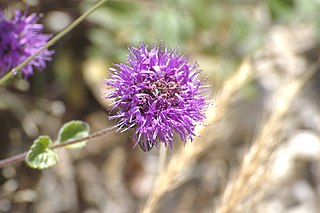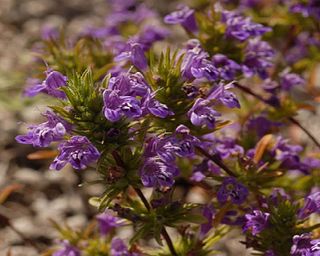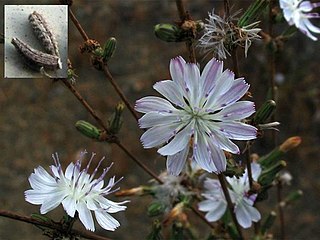
Acanthomintha ilicifolia, known by the common name San Diego thornmint, is a rare species of flowering plant in the mint family. It is native to Baja California and San Diego County, California, where it is a resident of the chaparral and coastal sage scrub plant communities and vernal pools.

Adolphia californica, known by the common names California adolphia, California prickbush, and spineshrub, is a species of flowering shrub in the buckthorn family.

Arctostaphylos obispoensis is a species of manzanita, known by the common names bishop manzanita and serpentine manzanita, endemic to California.

Atriplex tularensis is an extremely rare species of saltbush known by the common names Bakersfield smallscale, Tulare saltbush, and Tulare orach.

Fremontodendron mexicanum is a rare species of shrub in the mallow family known by the common names Mexican flannelbush, Mexican fremontia, and Southern flannelbush, that is endemic to the central Peninsular Ranges in Mexico and the United States.
Diplacus clevelandii is an uncommon species of monkeyflower known by the common name Cleveland's bush monkeyflower. It was formerly known as Mimulus clevelandii.
Monardella australis is a species of flowering plant in the mint family, known by the common name southern monardella.

Monardella hypoleuca is a species of flowering plant in the mint family, known by the common names thickleaf monardella and white leaf monardella.

Monardella lanceolata is a species of flowering plant in the mint family known by the common names mustang mint and mustang monardella. It is native to the mountains of California and Baja California, where it grows in chaparral, woodland, rocky slopes, and often disturbed habitat types.
Monardella linoides is a species of flowering plant in the mint family known by the common name flaxleaf monardella.
Monardella macrantha is a species of flowering plant in the mint family known by the common name red monardella. It is native to coastal mountain ranges of southern California and Baja California, where it grows in several habitat types, including chaparral, woodlands, and forest.

Monardella nana is a species of flowering plant in the mint family known by the common name yellow monardella. It is native to the Peninsular Ranges of southern California and northern Baja California, where it grows in several local habitat types, such as chaparral and mountain forest.
Monardella palmeri is a species of flowering plant in the mint family known by the common name Palmer's monardella.

Monardella purpurea is a species of flowering plant in the mint family known by the common names Siskiyou monardella and serpentine monardella.

Monardella undulata is an uncommon species of flowering plant in the mint family known by the common name curlyleaf monardella.

Oenothera californica, known by the common name California evening primrose, is a species of flowering plant in the evening primrose family.

Phacelia stellaris is a rare species of flowering plant in the borage family, Boraginaceae, known by the common names star phacelia and Brand's phacelia.

Pogogyne nudiuscula is a rare species of flowering plant in the mint family known by the common name Otay mesa mint. It is native to southern San Diego County, California, where it is known only from Otay Mesa near the border with Baja California. It was identified on land south of the Mexican border, but these occurrences have probably been extirpated. It is now known from seven vernal pool complexes just north of the border, and it is a federally listed endangered species of the United States.

Stephanomeria diegensis is a species of flowering plant in the aster family known by the common name San Diego wirelettuce. It is native to the coastal hills and ranges of southern California and Baja California, where it grows in many types of open habitat. It evolved as a hybrid of Stephanomeria exigua and S. virgata. Furthermore, it is thought to be the result of homoploid hybrid speciation, which is uncommon. The plant is frequently misidentified as one of its parents, especially if older taxonomic keys are used. This is an erect annual herb easily exceeding two meters in height. Its slender stem has many spreading branches. The basal leaves are linear to lance-shaped and up to 10 centimeters long. The leaves wither early and are absent for most of the year, giving the plant a twiglike appearance. Leaves on the upper stem are small and reduced. The inflorescences are usually clusters of flower heads located at intervals on the stiff branches. Each head has a cylindrical base lined with phyllaries. These are often glandular. The head contains several ray florets, each with an elongated tube and a white or pink-tinged ligule measuring around a centimeter long. The fruit is a grooved achene tipped with a spreading cluster of long, plumelike pappus bristles.

Suaeda californica is a rare species of flowering plant in the amaranth family known by the common name California seablite. It is endemic to San Luis Obispo County, California, where it is known from a few occurrences in the marshes around Morro Bay.















